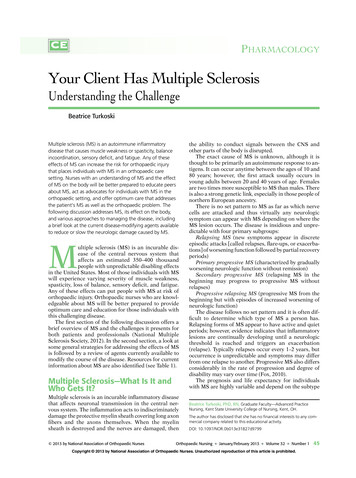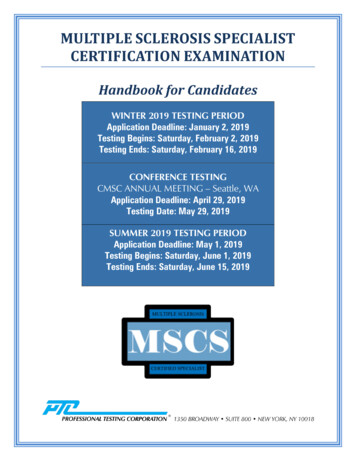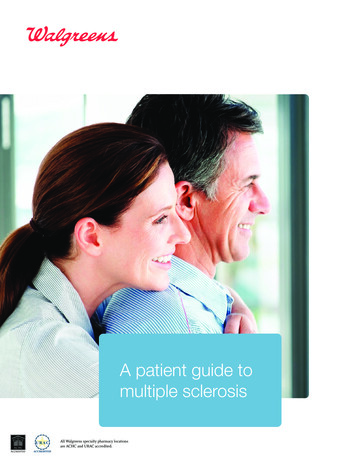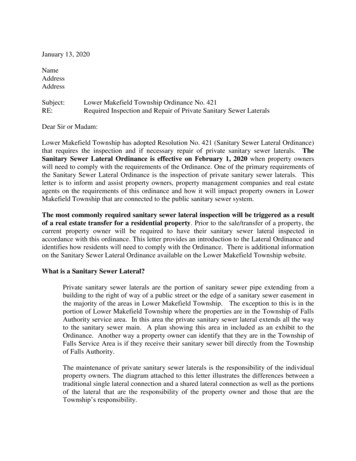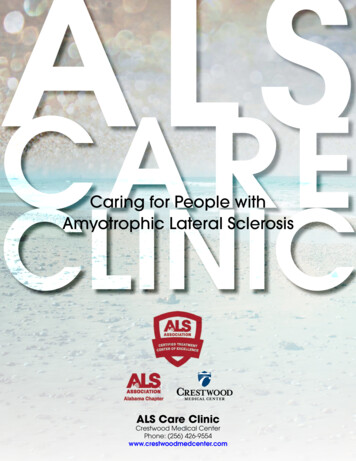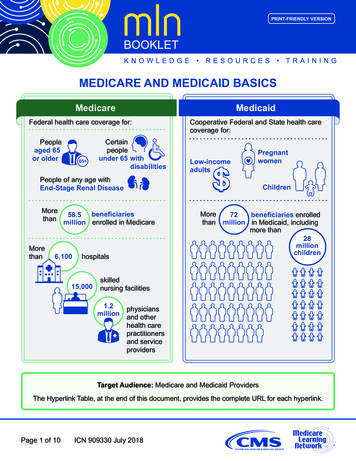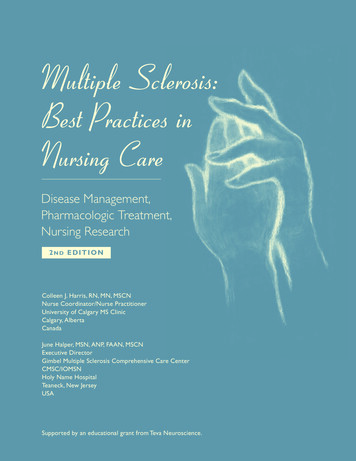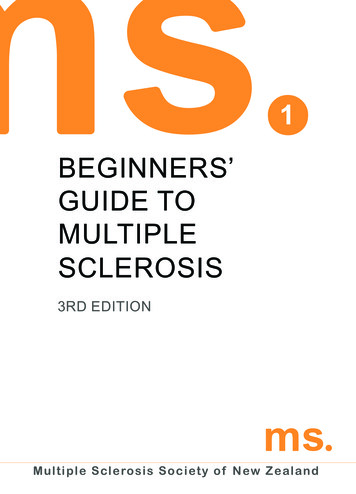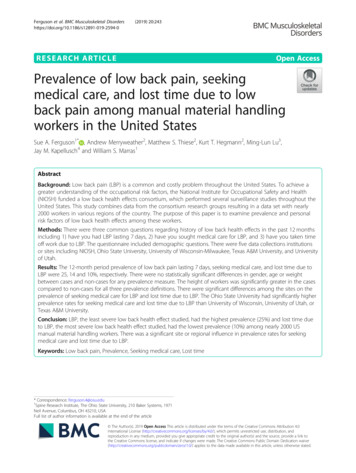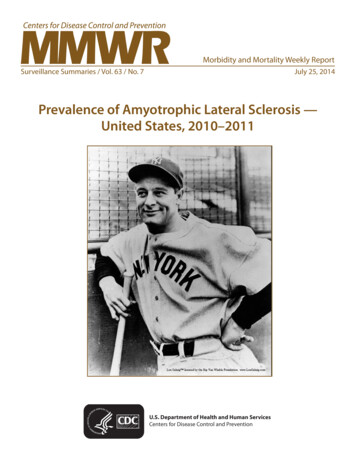
Transcription
Morbidity and Mortality Weekly ReportSurveillance Summaries / Vol. 63 / No. 7July 25, 2014Prevalence of Amyotrophic Lateral Sclerosis —United States, 2010–2011U.S. Department of Health and Human ServicesCenters for Disease Control and Prevention
Surveillance .3Results.6Discussion.7Limitations. 11Promoting the Registry. 11Registry Enhancements. 11Conclusion. 12Acknowledgments. 12References. 12Front cover photo: The baseball player Lou Gehrig, who died of amyotrophic lateral sclerosis, commonly known as “Lou Gehrig’s disease.”The MMWR series of publications is published by the Center for Surveillance, Epidemiology, and Laboratory Services, Centers for Disease Control and Prevention (CDC),U.S. Department of Health and Human Services, Atlanta, GA 30329-4027.Suggested citation: [Author names; first three, then et al., if more than six.] [Title]. MMWR 2014;63(No. SS-#):[inclusive page numbers].Centers for Disease Control and PreventionThomas R. Frieden, MD, MPH, DirectorHarold W. Jaffe, MD, MA, Associate Director for ScienceJoanne Cono, MD, ScM, Director, Office of Science QualityChesley L. Richards, MD, MPH, Deputy Director for Public Health Scientific ServicesMichael F. Iademarco, MD, MPH, Director, Center for Surveillance, Epidemiology, and Laboratory ServicesMMWR Editorial and Production Staff (Serials)Charlotte K. Kent, PhD, MPH, Acting Editor-in-ChiefChristine G. Casey, MD, EditorTeresa F. Rutledge, Managing EditorDavid C. Johnson, Lead Technical Writer-EditorJeffrey D. Sokolow, MA, Project EditorMartha F. Boyd, Lead Visual Information SpecialistMaureen A. Leahy, Julia C. Martinroe,Stephen R. Spriggs, Terraye M. StarrVisual Information SpecialistsQuang M. Doan, MBA, Phyllis H. KingInformation Technology SpecialistsMMWR Editorial BoardWilliam L. Roper, MD, MPH, Chapel Hill, NC, ChairmanMatthew L. Boulton, MD, MPH, Ann Arbor, MITimothy F. Jones, MD, Nashville, TNVirginia A. Caine, MD, Indianapolis, INRima F. Khabbaz, MD, Atlanta, GAJonathan E. Fielding, MD, MPH, MBA, Los Angeles, CADennis G. Maki, MD, Madison, WIDavid W. Fleming, MD, Seattle, WAPatricia Quinlisk, MD, MPH, Des Moines, IAWilliam E. Halperin, MD, DrPH, MPH, Newark, NJPatrick L. Remington, MD, MPH, Madison, WIKing K. Holmes, MD, PhD, Seattle, WAWilliam Schaffner, MD, Nashville, TN
Surveillance SummariesPrevalence of Amyotrophic Lateral Sclerosis —United States, 2010–2011Paul Mehta, MD1Vinicius Antao, MD1Wendy Kaye, PhD2Marchelle Sanchez, MS1David Williamson, PhD1Leah Bryan, MPH3Oleg Muravov, MD1Kevin Horton, DrPH11Division of Toxicology and Human Health Sciences, Agency for Toxic Substances and Disease Registry, Atlanta, Georgia2McKing Consulting Corporation, Atlanta, Georgia3Carter Consulting International, Atlanta, GeorgiaAbstractProblem/Condition: Amyotrophic lateral sclerosis (ALS), commonly known as Lou Gehrig’s disease, is a progressive and fatalneuromuscular disease for which no cure has been identified. Although ALS has no known definitive cause, familial ALS (ahereditary form) occurs in 5%–10% of cases. Many hypotheses have been formulated about what causes ALS, including chemicalexposures, occupational exposure, military service, infectious agents, nutritional intake, physical activity, and trauma. Worldwide,ALS affects white males aged 60 years more often than any other group. In the United States, ALS surveillance is necessary toestimate the incidence and prevalence of ALS and collect data on risk factors. ALS is not a nationally notifiable condition in theUnited States (i.e., it is not a reportable condition in all jurisdictions), and individual state reporting requirements differ, withMassachusetts being the only state that mandates reporting.Period Covered: October 19, 2010–December 31, 2011.Description of System: In 2009, the federal Agency for Toxic Substances and Disease Registry (ATSDR) implemented theNational ALS Registry to collect and analyze data regarding persons with ALS in the United States. The main goals of the Registry,as defined by the 2008 ALS Registry Act, are to describe the incidence and prevalence of ALS better, examine risk factors such asenvironmental and occupational exposures, and characterize the demographics of those living with ALS. The Registry uses a twopronged approach to identify all cases of ALS. The first approach uses four existing national administrative databases (maintainedby Medicare, Medicaid, the Veterans Health Administration, and the Veterans Benefits Administration) to identify prevalenceof ALS. The second approach uses a secure web portal (http://www.cdc.gov/als) that was launched to the public on October 19,2010, to identify cases not included in the four national administrative databases and to collect risk-factor data on known ALScases. ALS patients who have registered via the web portal can complete brief risk-factor surveys online that are intended to attain abetter understanding of ALS (e.g., genetics and environmental and occupational exposures) and help determine disease progression.Results: During October 19, 2010–December 31, 2011, a total of 12,187 persons meeting the surveillance case definition ofdefinite ALS were identified by the Registry, for a prevalence of 3.9 cases of ALS per 100,000 persons in the U.S. general population.Incidence cannot be measured because the date of diagnosis was not noted in all patient records. Overall, ALS was more commonamong white males, non-Hispanics, and persons aged 60–69 years. The age groups with the lowest number of persons with ALSwere age 18–39 years and age 80 years. Males had a higher prevalence rate of ALS than females overall and across all data sources.Interpretation: This is the first (and to date the only) effort to estimate the national prevalence of ALS in the United States. Usingthe combined approach of the national databases and the web-based portal enables researchers to estimate ALS prevalence moreaccurately. Registry findings for the prevalence of ALS are consistent with findings from long-established ALS registries in Europeand from smaller-scale epidemiologic studies conducted previously in the United States. Although incidence cannot be measuredwith Registry data at this time, incidence is being measured in smaller geographic areas that have participated in ATSDR’s Stateand Metropolitan Area ALS surveillance projects.Corresponding author: Paul Mehta, MD, Division of Toxicology andHuman Health Sciences, Agency for Toxic Substances and DiseaseRegistry. Telephone: 770-488-0556; E-mail: pum4@cdc.gov.Public Health Actions: Data collected by the National ALSRegistry are being used to better describe the prevalence of ALSin the United States and to help facilitate research. The combinedMMWR / July 25, 2014 / Vol. 63 / No. 71
Surveillance Summariesapproach of using national administrative databases and a self-enrollment web portal to collect data is novel and potentially couldbe used for other non-notifiable diseases such as Parkinson’s disease or multiple sclerosis. ATSDR is working closely with ALSadvocacy and support groups, researchers, health-care professionals, and others to promote the National ALS Registry in orderto capture all cases of ALS. To further enhance and strengthen the Registry, ATSDR is 1) adding new modules to the portal toexamine other potential risk factors, 2) launching a feasibility study for a novel ALS biorepository (available at http://wwwn.cdc.gov/als/ALSBioRegistry.aspx) linked to the Registry that would potentially provide biologic specimens from patient enrollees tohelp researchers learn more about disease etiology, 3) engaging in surveillance activities in selected states and large metropolitanareas to help test the completeness of the Registry as well as calculating incidence in these areas, and 4) using the Registry torecruit patient enrollees for new clinical trials and epidemiologic studies. Additional information about the National ALS Registryis available at http://www.cdc.gov/als or by calling toll-free at 1-877-442-9719.IntroductionBackgroundAmyotrophic lateral sclerosis (ALS), commonly known asLou Gehrig’s disease, is a progressive and fatal neuromusculardisease. Most persons die within 2–5 years of receiving adiagnosis of ALS (1). There is no known definitive causeof ALS, but a hereditary form of the disease, familial ALS,occurs in 5%–10% of cases (1). No cure has been identified.Riluzole (brand name Rilutek) is the only drug that hasbeen approved by the U.S. Food and Drug Administration(FDA) to treat ALS. Riluzole has been demonstrated to slowALS progression; however, it does not demonstrate markedimprovement in ALS symptoms and increases survival timeonly minimally (2). Although there is no blood test for ALS,the diagnosis of the disease has evolved. Diagnosis is basedon signs and symptoms as well as on neurophysiologic tests,primarily electromyograms. The El Escorial Criteria, a set ofclinical and diagnostic features that aim to rule out nonmotorneuron diseases and other motor neuron diseases with restrictedpresentations (i.e., those presenting as either upper or lowermotor neuron diseases but not both) (1,3) are used to classifyALS patients for research studies. Most persons who receive aninitial diagnosis of these other motor neuron diseases ultimatelywill progress to include both upper and lower motor neuronsand thus will receive an ALS diagnosis (1,4).ALS affects persons of all races and ethnicities. Severalpotential risk factors for ALS have been identified. Whites,males, those aged 60 years, and those with a family historyof the disease are more likely to develop ALS (1). Previousexposure to heavy metals (e.g., lead) also has been associatedwith an increased risk for ALS (5–7). Certain occupations(e.g., military service) have been identified as possible riskfactors (8–10). Nutritional intake, exposure to infectiousagents, physical activity, and trauma also have been identifiedas possible risk factors (11–17). However, most risk-factorstudies have had small sample sizes or have been conductedin limited geographic areas in populations that might not berepresentative of the U.S. population.ALS is not a nationally notifiable condition, and nationaldisease surveillance systems collect data related primarily toinfectious diseases (18). On the basis of studies mostly fromEurope (19–27), the incidence rate of ALS across all ages isestimated to be 1.6 persons per 100,000 population, andthe rate increases to five persons per 100,000 population inthe seventh decade of life (28). An estimated 5,000 personsreceive a diagnosis of ALS each year in the United States,with an estimated prevalence of 12,000 cases (28). ALS ismore prevalent in men than in women, with a typical age ofdiagnosis at age 55–75 years (1). Further analysis is necessary todetermine if the incidence or prevalence of ALS in the UnitedStates is rising or declining for all age groups and to assess therole of environmental or occupational risk factors.During 2006–2009, four ATSDR-funded pilot projects wereconducted to evaluate the feasibility of identifying cases of ALSby matching data from national administrative databases to sitespecific administrative and clinical databases (e.g., ALS clinicrecords) for January 1, 2001–December 31, 2005 (29). Thenational administrative databases included those maintained byMedicare, Medicaid, the Veterans Heath Administration, andthe Veterans Benefits Administration; these systems incorporatedata on approximately 90 million persons. Participating sitesincluded the Mayo Clinic (Rochester and Olmsted County,Minnesota), Emory University (Atlanta, Georgia), the SouthCarolina Budget and Control Board, and nine members of theHealth Management Organization Research Network in sevenstates (California, Massachusetts, Michigan, New Mexico,Oregon, Pennsylvania, and Wisconsin) (29).In 2008, the U.S. Congress passed the ALS Registry Act (30).ATSDR was designated to create and maintain the NationalALS Registry because of its previous pilot work on ALS, becauseALS has a potential environmental risk factor link, and becauseof ATSDR’s experience with designing other health registries(e.g., the World Trade Center Health Registry). The main goalsof the Registry, as defined by the 2008 ALS Registry Act, are to2MMWR / July 25, 2014 / Vol. 63 / No. 7
Surveillance Summariesdescribe the incidence and prevalence of ALS better, examinerisk factors such as environmental and occupational factors,and characterize the demographics of persons living withALS. ATSDR’s National ALS Registry will contribute criticaldata for further analysis of incidence, prevalence, and causalrisk factors. The Registry is also important as an innovativeuse of administrative and self-reported data to identify cases;traditionally, noncommunicable disease registries rely on datafrom health-care providers to identify cases.The purpose of this report is to describe the first (and todate the only) effort to estimate the national prevalence ofALS in the United States and selected descriptive risk factors.This report is intended for public health officials, clinicians,and researchers working to better understand and address theneeds of persons with ALS and their families.MethodsThe National ALS Registry is the first national registry touse existing administrative data (from Medicare, Medicaid,the Veterans Heath Administration, and the Veterans BenefitsAdministration) as a major source of case ascertainment. Analgorithm was developed and used to identify persons withALS on the basis of encounter* codes such as having ALSlisted as a code in the visit record or having such a code andhaving seen a neurologist, a death certificate listing ALS asa cause or contributing cause of death, and prescription forRiluzole (Box). Data from October 19, 2010–December 31,2011 are presented. All activities involving human subjectswere reviewed and approved by CDC’s Institutional ReviewBoard (IRB).Description of RegistryA health registry is a system containing uniform informationabout persons that is collected in a systematic and comprehensiveway to serve a predetermined purpose (31). These data typicallyare acquired, maintained, and updated over a prolonged periodof time, usually measured in years. Registry activities mightrange from only listing exposed persons with associated contactinformation to serving as a research repository of information(e.g., demographics, exposure, and health information). A publichealth registry is a registry that is set up to accomplish a publichealth goal or activity, including obtaining information onpersons who have either a particular disease, a condition (e.g., arisk factor) that predisposes them to the occurrence of a healthrelated event, or prior exposure to substances or circumstancesknown or suspected to cause adverse health effects.*An encounter is a record of a health-care service (e.g., a visit to a physician,hospitalization, x-ray, or laboratory test).BOX. Algorithm used to identify cases of amyotrophic lateral sclerosisThe Agency for Toxic Substances and Disease Registryapplied the algorithm developed as part of the four pilotprojects to the same data described in this report to identifypersons with amyotrophic lateral sclerosis (ALS) duringOctober 19, 2010–December 31, 2011. The algorithmcategorizes persons into three categories: “definite ALS,”“possible ALS,” and “not ALS.”Those included in the “definite ALS” category met oneor more of the following criteria: an encounter* coded for ALS (InternationalClassification of Diseases, Ninth Revision [ICD-9]335.20) in 1 year in the same source and either adeath certificate listing ALS as a cause of death or aprescription for Riluzole; OR an encounter coded for ALS (ICD-9 335.20) in 2 years and a neurologist visit in the same source; OR a person aged 65 years with an encounter coded forALS (ICD-9 335.20) in Medicare and a neurologistvisit; OR an encounter coded for ALS (ICD-9 335.20) in 1 year and a neurologist visit in the same source andan encounter coded for ALS in another source; OR an encounter coded for ALS (ICD-9 335.20 orVeterans Benefits Administration 8017 codes) in threeor more sources; OR an encounter coded for ALS (ICD-9 335.20) in 1 yearand five or more neurologist visits in the same source.Those included in the “not ALS” category met one ormore of the following criteria: no encounter coded for ALS (ICD-9 335.20) in anysource and no prescription for Riluzole; OR an encounter coded for ALS (ICD-9 335.20) in only1 year but no neurologist visit in the same source; OR a person aged 18 years.Those included in the “possible ALS” category includedeveryone not determined to be either “definite ALS” or“not ALS.”* A record of a health-care service (e.g., a visit to a physician, hospitalization,x-ray, or laboratory test).The National ALS Registry uses a two-pronged approachto identify cases of ALS in the United States. These cases areidentified for surveillance purposes and not for diagnosis ortreatment. The first approach uses records from four existingnational administrative databases (Medicare, Medicaid, theVeterans Heath Administration, and the Veterans BenefitsAdministration) to identify ALS cases on the basis of anMMWR / July 25, 2014 / Vol. 63 / No. 73
Surveillance Summariesalgorithm developed through pilot projects (29). The secondapproach, which was launched to the public on October19, 2010, uses a secure web portal (http://www.cdc.gov/als) to capture cases that are not included in the nationaladministrative databases. This approach allows patients toself-identify, enroll in the National ALS Registry if screeningcriteria are met, and take brief surveys regarding risk factors(32). The unit of analysis for the Registry is a person witha single (i.e., unique) record. Merging records for personsidentified as having ALS from the administrative databaseswith those persons who enrolled in the National ALS Registryweb portal creates a unique record after data are de-duplicatedby using a combination of the last five digits of the person’sSocial Security number, sex, month and year of birth, and firstand last name. This ensures that persons who are identified inboth the administrative databases and the web portal are notcounted twice.Misclassification of age at diagnosis is likely in theadministrative data because the date of diagnosis is not includedand must be estimated on the basis of the first date of a medicalservice encounter. Because of the individual variation in thetime lag between diagnosis and benefit approval, using narrowage categories increases the likelihood of miscategorization.For this reason, standard 10-year age categories were used toreduce the potential for misclassification of age at diagnosis.National Administrative DatabasesMedicare is a U.S. government-provided health-careinsurance program for persons aged 65 years, some disabledpersons aged 65 years, and persons of all ages with endstage renal disease. Persons approved for the Social SecurityAdministration Disability Insurance Benefit or SupplementalSecurity Income because of ALS can begin receiving Medicarewithout a 24-month waiting period. Medicaid is the U.S.health program for persons and families with low incomesand limited resources; Medicaid data include inpatient,outpatient, and pharmacy records for persons receiving thisbenefit. Veterans Health Administration data include inpatient,outpatient, and pharmacy records for veterans receiving healthcare benefits. Approximately 20% of veterans qualify for thisbenefit. Veterans Benefits Administration data include recordsfor veterans receiving pensions or compensation for servicerelated disabilities. In 2008, the Veterans Administrationdetermined that ALS is to be considered a service-connectedcondition regardless of when it occurred in relationship tomilitary service and anyone who served at least 90 days ofcontinuous active duty in the U.S. military may qualify forthis benefit (33).4MMWR / July 25, 2014 / Vol. 63 / No. 7Algorithm Used to Identify CasesThe National ALS Registry used an existing algorithm toidentify persons with ALS (Figure 1 and Box). On the basis ofknowledge of ALS and findings from other studies (34–36),individual and combined variables were entered into thealgorithm. The variables included International Classificationof Diseases Ninth Revision (ICD-9) 335.20 and VBA 8017codes, a prescription for Riluzole, and the frequency of visitsto a neurologist. Only data for persons categorized as “definiteALS” are included in this report. Those determined to be“possible ALS” will be reevaluated as additional years of databecome available.The algorithm was developed initially during the pilotprojects and categorized persons as either “definite ALS,”“possible ALS,” or “not ALS,” with a sensitivity of 87%and specificity of 85% (29). During the pilot projects thisalgorithm identified persons with ALS using data from thenational databases by identifying individual patient encounters(records of health-care services) with an ICD-9 code for anymotor neuron disease (335.2–335.29) and Veterans BenefitsAdministration–specific codes for any motor neuron diseasefor the specific project catchment area. ATSDR then providedindividual encounter data from the national databases,including full name and social security number, to the pilotproject sites (29). In addition, pilot sites examined site specificadministrative and clinical databases to identify any casesthat might have been missed during review of the nationaldatabases’ encounter data. Pilot sites completed a standardizedspreadsheet for each person found in either a national or pilotsite database and combined all encounter records into onerecord per person by database (29). This step was not repeatedduring the current study period (i.e., case classification reliedonly on the use of the algorithm) because the coding schememost likely to identify those persons who had definite ALShad been determined during the pilot study. At that time,researchers had abstracted accessible medical records by usinga standardized medical records abstraction form designed bythe project neurologists for signs and symptoms of ALS andelectromyography results, when available. Using these data,a neurologist had assigned diagnoses by using the El EscorialCriteria (3), a tool to characterize the certainty of an ALSdiagnosis in clinical practice and research, which was consideredthe “gold standard.” Therefore, the sensitivity and specificityof both individual and combined variables were examinedby comparing what was documented in the administrativedatabases against the El Escorial Criteria classification assignedby the neurologist. ATSDR then combined the data from thefour pilot projects (29).
Surveillance SummariesFIGURE 1. National Amyotrophic Lateral Sclerosis (ALS) Registry methodologyNationaldatabases*Web ithmNot ollowupValidationquestionsDefiniteALSpatientsNot ALSpatientsRiskfactormodules* Maintained by Medicare, Medicaid, the Veterans Health Administration, and the Veterans Benefits Administration.† Available at http://www.cdc.gov/als.Self-Identification Through a SecureWeb PortalSurvey Modules and Risk-FactorDefinitionsNot all persons with ALS can be identified through theexisting national databases because of eligibility requirementsfor each of the sources as well as potential obstacles to applyingfor benefits (e.g., economic or educational disadvantage).Therefore, a secure web portal was created to help identifyALS cases not found in the administrative databases. To enterthe National ALS Registry through its web portal, patientsmust answer a series of validation (screening) questions.These validation questions were obtained from the VeteransAdministration’s ALS Registry (which is no longer enrollingpersons with ALS) and were found to be very accurate; 93.4%of those who passed the screening questions were determinedby a neurologist to have ALS/motor neuron disease (37). Thosepersons who do not “pass” the ATSDR screening questionscannot register and are instructed to call Registry staff formore information.During October 19, 2010–December 31, 2011, theRegistry web portal had seven brief risk-factor survey modulesavailable that persons with ALS could use to help researcherslearn more about the disease. These modules captured thefollowing current and historic information about enrollees:sociodemographics, occupational history, military history,physical activity, alcohol consumption and cigarette smoking,and family history of neurodegenerative diseases. These topicsare mentioned in the literature as potentially being associatedwith the disease. The seventh module collected informationon a person’s disease progression (i.e., ALS Functional RatingScale). Patients answer all modules only once except for themodule pertaining to disease progression, which is offered forcompletion multiple times per year. More risk-factor modules(e.g., detailed residential history and residential pesticide use)have come online since January 1, 2012, and results will bedescribed in subsequent reports.Current smokers were defined as persons reporting havingsmoked one or more cigarettes per day for 6 months andcurrently smoking. Former smokers were defined as personsreporting having smoked one or more cigarettes per day for 6 months but not currently smoking. Nonsmokers weredefined as persons reporting never having smoked one or morecigarettes per day for 6 months. Current alcohol drinkerswere defined as persons reporting having consumed alcoholicbeverages at least once a month for 6 months and currentlyPrevalence CalculationThe prevalence of ALS was calculated from the Registry byusing the de-duplicated total number of persons with ALSidentified through administrative data and those who selfidentified for the numerator. The 2011 Census was used forthe denominator (38).MMWR / July 25, 2014 / Vol. 63 / No. 75
Surveillance Summariesdrinking alcohol. Former drinkers were defined as personsreporting having consumed alcoholic beverages at least oncea month for 6 months and not currently drinking alcohol.Nondrinkers were defined as persons reporting not havingconsumed any alcoholic beverages in a month for 6 months.Military-service history was defined as ever having been amember of the armed forces. Titles of longest-held jobs andcorresponding industries were selected by respondents frompredetermined drop-down menus.ResultsA total of 12,187 persons were identified as “definite ALS”across the four national databases and through web portalregistration during October 19, 2010–December 31, 2011(Table 1). The overall prevalence rate of ALS was 3.9 per100,000 persons and increased as age increased. The agegroup 18–39 years had the lowest prevalence rate (0.5 per100,000 persons), and the age group 70–79 years had thehighest prevalence rate (17.0 per 100,000 persons). Whenthe self-enrollment portal data were analyzed alone, the agegroup 50–59 years had the highest prevalence rate of ALS.ALS patients identified in the national databases tended tobe older than those identified through the web portal. Maleshad a higher overall prevalence rate (4.8 per 100,000 persons)than females (3.0 per 100,000 persons); across each data sourceindividually and overall. The ratio of males to females was 1.56.The prevalence rate for whites was twice that of blacks; whiteshad a prevalence rate of 4.2 per 100,000 persons comparedwith 2.0 per 100,000 persons for blacks (Table 2). Prevalencerates by age group, sex, and race are provided (Figures 2–4).For the 10,971 patients for whom race was known, whitesaccounted for 79.1% of all cases identified when all datasources were combined, whereas blacks accounted for 6.5%.The proportion of whites who registered was higher in the webportal when compared with the national databases (Table 2) andtherefore might not be representative of all persons with ALS.Of the 1,647 respondents who provided information onsmoking history, approximately half of the respondents wereeither former or current smokers while half were nonsmokers.Of the 1,640 respondents who provided information onalcohol use, fewer respondents identified themselves as currentdrinkers, more identified themselves as former drinkers, anda similar percentage identified themselves as nondrinkerswhen compared with national estimates (39). Of the 1,828respondents who provided information on educationalattainment, a total of 71% of respondents reported somecollege or higher education. Of the 1,651 respondents whoprovided information on military service, nearly one quarter(23%) of respondents reported a history of military service. Asummary of descriptive risk-factor data is provi
Oregon, Pennsylvania, and Wisconsin) (29). In 2008, the U.S. Congress passed the ALS Registry Act (30). ATSDR was designated to create and maintain the National ALS Registry because of its previous pilot work on ALS, because ALS has a potential environmental risk factor link, and because of ATSDR's experience with designing other health .
